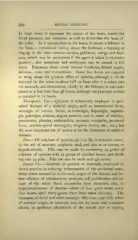Page 540 - My FlipBook
P. 540
538 — DENTAL MEDICINE.
In large doses it depresses the action of the heart, lowers the
blood pressure, and enfeebles as well as diminishes the beats of
the pulse. As it accumulates in the brain, it causes a fullness in
the head, a constricted feeling about the forehead, a buzzing or
ringing in the ears tinnitus aurium^ giddiness, vertigo and deaf-
ness, which may be permanent if the agent is taken in excessive
quantity ; also amaurosis and amblyopia may be caused by full
doses. Poisonous doses cause intense headache, dilated pupils,
delirium, coma and convulsions. Some five hours are required
to bring about the greatest effect of quinine, although it can be
detected in the urine in about half an hour after it is taken into
the stomach, and elimination, chiefly by the kidneys, is not com-
pleted in a less time than 48 hours, although the principal portion
is excreted in 12 hours.
Therapeutic Uses.—Quinine is extensively employed in peri-
odical diseases of a malarial origin, such as intermittent fever,
neuralgia of various forms, as enteralgia, hepatalgia, nephral-
gia, gastralgia, sciatica, angina pectoris, and in cases of debility,
pneumonia, pleurisy, endocarditis, pyaemia, erysipelas, puerperal
fever, cerebro-spinal meningitis, eruptive fevers, etc., etc., but
the most important use of quinia is for the treatment of malarial
diseases.
Dose.—Of sulphate of quinine, gr. j to 3j, in aromatic water,
by the aid of aromatic sulphuric acid, and also as an enema, or
hypodermically. Pills may be made by combining 24 grains of
sulphate of quinine with 14 grains of clarified honey, and divid-
ing into 24 pills. Pills can also be made with glycerine.
Dental Uses.—Sulphate of quinine is internally employed in
dental practice in reducing inflammation of the peridental mem-
brane when resorted to in the early stages of the disease, and be-
fore effusion of inflammatory products, cell proliferation and es-
cape of the white blood corpuscles have occurred; also, in
hypersensitiveness of dentine—three or four grain doses every
four hours, until thirty grains have been taken (Klump). The
treatment of facial and other neuralgic affections, especially when
of malarial origin, in cancrum oris, for its tonic and stimulant
effects, in aphthous ulcerations of the mouth and in scurvy.


